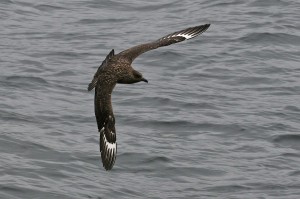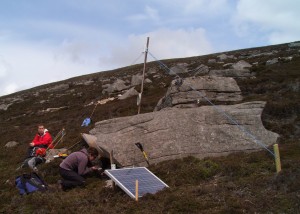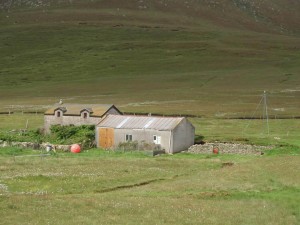The UK Government has a commitment to obtain 15% of the country’s electricity from renewable sources by 2020. Many offshore wind farms are therefore under construction or proposed. These wind farms might affect bird populations through:

- Displacement due to disturbance;
- Presenting a barrier to migrating birds and birds commuting between breeding sites and feeding areas;
- Collision mortality;
- Indirect effects because of changes in habitat or prey availability.
This project used UvA-BiTS technology to investigate these possible effects, using the Great Skua as a model species. In summers 2010 and 2011, UvA-BiTS tags were fitted to 14 adult Great Skuas, breeding on the island of Foula, Shetland (60°8’N, 2°5’W) and, in a collaborative study of the Environmental Research Institute (University of the Highlands and Islands), to 10 further Great Skuas from Hoy, Orkney (58°8′N, 3°3′W) in 2011. Both Foula and Hoy are Special Protection Areas (SPAs) and the breeding populations of Great Skuas are one of the designated features of these sites. Although there are currently no offshore wind farms close to Foula or Hoy, there are plans to develop offshore renewables in these areas, and Great Skuas might also interact with existing and proposed wind farm sites on migration.
Results show that breeding Great Skuas from Foula predominantly headed north-west for foraging. Birds did not visit existing and proposed wind farm sites during the breeding season. The risk of seabirds colliding with offshore wind turbines is influenced by flight height, and analyses also considered the flight altitude data derived from the GPS devices. Individuals from Hoy did overlap with wind turbines in the Moray Firth and also wave and tidal sites in the Pentland Firth and Orkney waters. However, the amount of time birds spent in these areas was low.


Assessment of the potential effects of the attachment of tags to birds have been carried out across studies, based on comparison with control groups. While for Lesser Black-backed Gull, we found no impacts of tagging on breeding success or return rates, for Great Skua, despite there being no apparent effects of tagging on territory attendance or breeding success, there was strong evidence for reduced over-winter return rates. Consequently, the study was halted in 2012 and no further devices deployed. For further information, see Thaxter et al. (2014, 2016).
Contact persons, funders and participants
Chris Thaxter, British Trust for Ornithology chris.thaxter@bto.org
Viola Ross-Smith, British Trust for Ornithology viola.ross-smith@bto.org
Willem Bouten, University of Amsterdam Institute for Biodiversity and Ecosystem Dynamics / Instituut voor Biodiversiteit en Ecosysteem Dynamica (IBED) w.bouten@uva.nl
Elizabeth Masden, Environmental Research Institute elizabeth.masden@uhi.ac.uk
The Foula skua study was funded by the Department of Energy & Climate Change.
The Hoy Skua study was funded by the Marine Renewable Energy and the Environment (MaREE) project (funded by Highlands and Islands Enterprise, the European Regional Development Fund, and the Scottish Funding Council).University of the Highlands and Islands
Participants:
- Department of Energy & Climate Change
- Highlands and Islands Enterprise
- European Regional Development Fund
- Scottish Funding Council
Supported by Foula Heritage
Related publications
Ross-Smith, V.H., Thaxter, C.B., Masden, E.A., Shamoun-Baranes, J., Burton, N.H.K., Wright, L.J., Rehfisch, M.M. & Johnston, A. 2016. Modelling flight heights of Lesser Black-backed Gulls and Great Skuas from GPS: a Bayesian approach. Journal of Applied Ecology 53: 1676–1685.
Thaxter, C.B., Ross-Smith, V.H., Clark, J.A., Clark, N.A., Conway, G.J., Masden, E.A., Wade, H.M., Leat, E.H.K., Gear, S.C., Marsh, M., Booth, Furness, R.W., Votier, S.C. & Burton, N.H.K. 2016. Contrasting effects of GPS device and harness attachment on adult survival of Lesser Black-backed Gulls Larus fuscus and Great Skuas Stercorarius skua. Ibis 158: 279-290.
Thaxter, C.B., Ross-Smith, V.H., Clark, J., Clark, N.A., Conway, G.J., Marsh, M., Leat, E.H.K & Burton, N.H.K. 2014. A trial of three harness attachment methods and their suitability for long-term use on Lesser Black-backed Gull and Great Skua. Ringing & Migration29: 65-76.
Wade, H.M., Masden, E.A., Jackson, A.C., Thaxter, C.B., Burton, N.H.K., Bouten, W. & Furness, R.W. 2014. Great skua (Stercorarius skua) movements at sea in relation to marine renewable energy developments. Marine Environmental Research 101: 69-80

